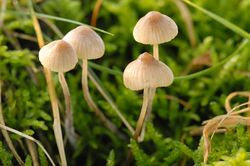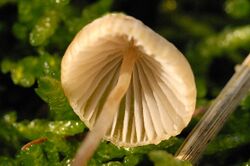Biology:Mycena flavoalba
| Mycena flavoalba | |
|---|---|

| |
| Scientific classification | |
| Domain: | Eukaryota |
| Kingdom: | Fungi |
| Division: | Basidiomycota |
| Class: | Agaricomycetes |
| Order: | Agaricales |
| Family: | Mycenaceae |
| Genus: | Mycena |
| Species: | M. flavoalba
|
| Binomial name | |
| Mycena flavoalba (Fr.) Quél.
| |
| Synonyms[1] | |
|
Agaricus flavoalbus Fr. | |
| Mycena flavoalba | |
|---|---|
| Mycological characteristics | |
| gills on hymenium | |
| cap is conical | |
| hymenium is adnate | |
| stipe is bare | |
| spore print is white | |
| ecology is saprotrophic | |
| edibility: inedible | |
Mycena flavoalba, commonly known as the ivory bonnet, is a species of inedible mushroom in the family Mycenaceae. The cap is initially conical in shape, before becoming convex and then flattening out; it may reach dimensions of up to 1.5 cm (0.6 in) across. The cap color is ivory-white to yellowish white, sometimes more yellowish at the center. The tubular stems are up to 8 cm (3.1 in) long and 2.5 mm (0.10 in) thick, and have long, coarse white hairs at their bases. The mushroom is found in Europe, the Middle East, and North America, where it grows scattered or in dense groups under conifers and on humus in oak woods.
Taxonomy, classification, and naming
First described as Agaricus flavoalbus by Swedish mycologist Elias Magnus Fries in 1838, it was assigned its current name in 1872 by Lucien Quélet.[2] American mycologist Rolf Singer transferred the species to the genera Hemimycena and Marasmiellus in 1938[3] and 1951,[4] respectively. Singer later changed his mind about these placements, and his 1986 Agaricales in Modern Taxonomy, he considered the species a Mycena.[5] The binomials resulting from these transfers are considered synonyms; another synonym is Mycena luteoalba (Bolton) Gray.[1]
Mycena flavoalba is placed in the section Adonideae of the genus Mycena, alongside species such as M. adonis and M. floridula.[6]
The specific epithet flavoalba ("yellow-white") is a compound of the Latin adjectives flavus ("yellow) and alba ("white").[7] The mushroom's common name is the "ivory bonnet".[8]
Description
The cap of M. flavoalba is 1–2 cm (0.4–0.8 in) in diameter, conical when young, becoming somewhat bell-shaped, broadly conic or at times nearly convex. It may develop a papilla (a nipple-like structure) in its center. The cap margin is initially pressed against the stem, but in maturity either flares out or curves inward slightly. The cap surface is smooth, moist, and partially translucent, so that the outline of the gills underneath the cap may be seen. The mushroom is hygrophanous (changing color as it loses or gains moisture), being cream-buff to yellowish initially, with a paler (almost white) margin, and fading to buff in the center and yellowish-white along the margin when dry. The flesh is yellowish to white, thick under the disc but otherwise thin, moderately fragile, and without any distinctive odor and taste.[9]
The gills are ascending and somewhat hooked or toothed, narrow at first but becoming rather broad (2.5 mm and becoming 3–4 mm). They are nearly equal in width throughout or slightly ventricose in age, with a spacing that is close to subdistant. About 18–24 gills reach the stem, with two tiers of lamellulae (short gills that do not extend fully from the cap margin to the stem) that may develop veins running between them. The gills are white to creamy-white with edges that are even and whitish, and waxy in appearance and consistency. The stem is 3–8 cm (1.2–3.1 in) long, 1–2.5 mm (0.04–0.10 in) thick, equal, tubular, somewhat elastic, cartilaginous, and not particularly fragile. The base of the stem is either strigose (covered with sharp, straight, stiff white hairs) or surrounded with a matted white mycelium. Above the base, the stem is smooth, and pruinose toward the apex. When moist it is translucent with slight ripples running transversely, and white to pale yellow in color.[9] Mycena flavoalba is considered inedible.[10]
Microscopic characteristics
The spores are 7–9 by 3–4.5 μm, ellipsoid, and nonamyloid. The basidia (spore-bearing cells) are four-spored. The pleurocystidia and cheilocystidia (cystidia found on the face and edge of a gill, respectively) are similar in structure and abundant, ventricose with long, rather narrow necks, and measure 46–62 by 9–14 μm. The neck is often encrusted with a mucilaginous substance, but it is otherwise smooth and hyaline. The flesh of the gill is homogeneous, and stains pale yellow in iodine. The flesh of the cap has a thin, poorly differentiated pellicle (a thin membrane), a somewhat differentiated hypoderm (that is most pronounced in old caps) and the remainder is made up of somewhat enlarged cells that stain pale yellow in iodine.[9]
Similar species
Mycena flavoalba bears resemblance to some members of the genus Hemimycena, such as H. lactea and H. delectabilis. It can be distinguished from these species by its white to yellowish cap, and differences in the shape of both its spores and caulocystidia (cystidia on the stem).[6] H. conidiogena, a Spanish species newly described from in 2005, is also similar in appearance, but differs in the distribution of pigment in the cap, and the differential staining in response to the dye cresyl blue—M. flavoalba is positive, while H. conidiogena is negative.[11]
Habitat and distribution
The fruit bodies of Mycena flavoalba grow scattered to densely gregarious on needle beds under conifers, and on humus in oak woods during the autumns months. Although generally rare, the species sometimes occurs in large quantities in certain localities. In the United States, it has been collected from Colorado, Idaho, Michigan, North Carolina, Oregon, Washington (state) , Wyoming,[9] Florida,[12] and Kansas .[13] It is also found in Europe,[10][14][15] and Israel.[16] The species is listed as "Least Concern" in the Danish Red Data Book.[17]
References
- ↑ 1.0 1.1 "Mycena flavoalba (Fr.) Quél.". Index Fungorum. CAB International. http://www.speciesfungorum.org/Names/SynSpecies.asp?RecordID=201778.
- ↑ Quélet L. (1872). "Les Champignons de Jura et des Vosges" (in fr). Mémoires de la Société d'Émulation de Montbéliard 5: 103.
- ↑ Singer R. (1943). "Das System der Agaricales. III". Annales Mycologici 41: 123.
- ↑ Singer R. (1949). "The Agaricales in modern taxonomy". Liloa 22 (2): 123.
- ↑ Singer R. (1986). The Agaricales in Modern Taxonomy (4th ed.). Koenigstein: Koeltz Scientific Books. p. 413. ISBN 3-87429-254-1.
- ↑ 6.0 6.1 "Mycena flavoalba" (Aronsen A). A key to the Mycenas of Norway. 2009. http://home.online.no/~araronse/Mycenakey/flavoalba.htm.
- ↑ Common British fungi: a guide to the more common larger Basidiomycetes of the British Isles. London: P. R. Gawthorn. 1950.
- ↑ "Recommended English Names for Fungi in the UK". British Mycological Society. http://www.fungi4schools.org/Reprints/ENGLISH_NAMES.pdf.
- ↑ 9.0 9.1 9.2 9.3 Smith, p.166–68.
- ↑ 10.0 10.1 Phillips R. "Mycena flavoalba". Rogers Mushrooms. http://www.rogersmushrooms.com/gallery/DisplayBlock~bid~6484~gid~~source~gallerydefault.asp.
- ↑ "Hemimycena conidiogena, a new cistophilous basidiomycete". Mycotaxon 91: 323–32. 2005. http://botanique.univ-lille2.fr/fileadmin/user_upload/documents/pdf_pam/Moreau_Hemimyc_conidio_2005.pdf. Retrieved 2010-09-27.
- ↑ Kimbrough JW. (2000). Common Florida Mushrooms. University of Florida, Extension Institute of Food and Agricultural Sciences. pp. 164–65. ISBN 978-0-916287-30-6.
- ↑ "Notes on the fleshy fungi of Kansas". Transactions of the Kansas Academy of Science 55 (3): 282–86. 1952. doi:10.2307/3626234.
- ↑ Emmett EE. (1993). "British Mycena species, 5". Mycologist 7 (2): 63–67. doi:10.1016/S0269-915X(09)80644-7. ISSN 0269-915X.
- ↑ Gerhardt E. (1990). "Checkliste der Großpilze von Berlin (West) 1970-1990". Englera (13): 3–5, 7–251. doi:10.2307/3776760.
- ↑ Binyamin N. (1973). "White-spored agarics new to Israel". Israel Journal of Botany 22 (1): 38–46. ISSN 0021-213X.
- ↑ "NERI - The Danish Red Data Book - Mycena flavoalba (Fr.) Quél.". National Environmental Research Institute. http://www2.dmu.dk/1_Om_DMU/2_Tvaer-funk/3_fdc_bio/projekter/redlist/data_en.asp?ID=5814&gruppeID=90.
Cited text
- Smith AH. (1947). North American species of Mycena. Ann Arbor: University of Michigan Press.
Wikidata ☰ Q3914302 entry


